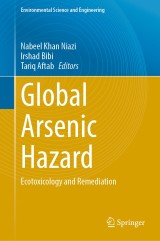Details

Global Arsenic Hazard
Ecotoxicology and RemediationEnvironmental Science and Engineering
|
213,99 € |
|
| Verlag: | Springer |
| Format: | |
| Veröffentl.: | 02.12.2022 |
| ISBN/EAN: | 9783031163609 |
| Sprache: | englisch |
Dieses eBook enthält ein Wasserzeichen.
Beschreibungen
This book provides a plethora of information about global arsenic (As) contamination and the challenges for environment. Arsenic is a naturally occurring metalloid that is widely distributed in water, soil, air and biota from natural and anthropogenic sources. Arsenic has been found in drinking water in over 100 countries worldwide, which caused a major public health issue including: cardiovascular disorders, diabetes, and cancers of various organs - these are some of the general health effects of As exposure. Exposure of plants to As, even at very low concentrations, can cause many morphological, physiological, and biochemical changes. The recent research on As in the water-soil-plant-human systems indicates that As toxicity to plants varies with As speciation in plants, type of plant species and with other soil factors controlling As accumulation in plants. In recent years, the development of efficient green chemistry methods for detoxification of trace metal poisoning has become a major focus of researchers. It has been investigated in order to find an eco-friendly and recyclable technique for the removal of As contamination from the natural resources.<div><br></div><div>Understanding the significance of As hazard and roles of sustainable or eco-friendly approaches in its mitigation, we intend to bring forth a comprehensive volume “Global Arsenic Hazard - Ecotoxicology and Remediation" highlighting the various prospects involved in current scenario. We are hopeful that this comprehensive volume will furnish the requisite of all those who are working or have interest in the proposed topic.</div>
<div>Chapter 1 Global arsenic hazard and sustainable development.- Chapter 02 Global arsenic contamination of groundwater, soil, and food crops and health impacts.- Chapter 03 Arsenic contamination in rice and the possible mitigation options.- Chapter 04 Arsenic in gold mining wastes: an environmental and human health threat in Ghana.- Chapter 05 Arsenic Contamination in Karst Regions.- Chapter 06 Arsenic dynamics in paddy rice ecosystems and human exposure.- Chapter 07 Interaction of arsenic with biochar in water and soil: principles, applications, and prospects.- Chapter 08 Accumulation and translocation of arsenic in rice with its distributional flow during cooking: A study in West Bengal, India.- Chapter 09 An overview of arsenic contamination in water resources of Pakistan, risk assessment and remediation strategies.- Chapter 10 Approaches for stochastic modelling of toxic ion adsorption at crystal-water interfaces: A case study of arsenic.- Chapter 11 A comparison of technologies for remediation of arsenic-bearing water: The significance of constructed wetlands.- Chapter 12 Application of nanotechnology in mitigating arsenic stress and accumulation in crops: Where we are and where we are moving towards?.- Chapter 13 Nano-enabled remediation of arsenic-bearing water and wastewater.- Chapter 14 Molecular Aspects of Arsenic Responsive Microbes in Soil-Plant-Aqueous Triphasic Systems.- Chapter 15 Phosphate-induced phytoextraction by Pteris vittata reduced arsenic uptake by rice.- Chapter 16 Modified biosorbents as potential biomaterials for arsenic removal from contaminated water.- Chapter 17 Phytoremedial potential of perennial woody vegetation under arsenic-contaminated conditions in diverse environments.- Chapter 18 Bacterial tolerance and biotransformation of arsenic in soil and aqueous media.- Chapter 19 Arsenic bioremediation of soil and water systems - an overview.- Chapter 20 Modern aspects of phytoremediation of arsenic-contaminated soils.- Chapter 21 Nanoparticulate iron oxide minerals for arsenic removal from contaminated water.- Chapter 22 Arsenic-toxicity and tolerance: phytochelatin-mediated detoxification and genetic engineering-based remediation.- Chapter 23 Distribution of arsenic in rice grain from West Bengal, India: Its relevance to geographical origin, variety, cultivars and cultivation season. </div>
<div>This book provides a plethora of information about global arsenic (As) contamination and the challenges for environment. Arsenic is a naturally occurring metalloid that is widely distributed in water, soil, air and biota from natural and anthropogenic sources. Arsenic has been found in drinking water in over 100 countries worldwide, which caused a major public health issue including: cardiovascular disorders, diabetes, and cancers of various organs - these are some of the general health effects of As exposure. Exposure of plants to As, even at very low concentrations, can cause many morphological, physiological, and biochemical changes. The recent research on As in the water-soil-plant-human systems indicates that As toxicity to plants varies with As speciation in plants, type of plant species and with other soil factors controlling As accumulation in plants. In recent years, the development of efficient green chemistry methods for detoxification of trace metal poisoning has become a major focus of researchers. It has been investigated in order to find an eco-friendly and recyclable technique for the removal of As contamination from the natural resources.<div><br></div><div>Understanding the significance of As hazard and roles of sustainable or eco-friendly approaches in its mitigation, we intend to bring forth a comprehensive volume “Global Arsenic Hazard - Ecotoxicology and Remediation" highlighting the various prospects involved in current scenario. We are hopeful that this comprehensive volume will furnish the requisite of all those who are working or have interest in the proposed topic.</div></div>
Provides a plethora of information about global arsenic contamination and challenges for environment Explains strategies, tools, and techniques used in arsenic remediation Covers an array of topics and issues related to sustainable development
Diese Produkte könnten Sie auch interessieren:

Decision Support Systems for Risk-Based Management of Contaminated Sites

von: Antonio Marcomini, Glenn Walter Suter II, Andrea Critto

96,29 €

Dynamics of Mercury Pollution on Regional and Global Scales

von: Nicola Pirrone, Kathryn R. Mahaffey

149,79 €














